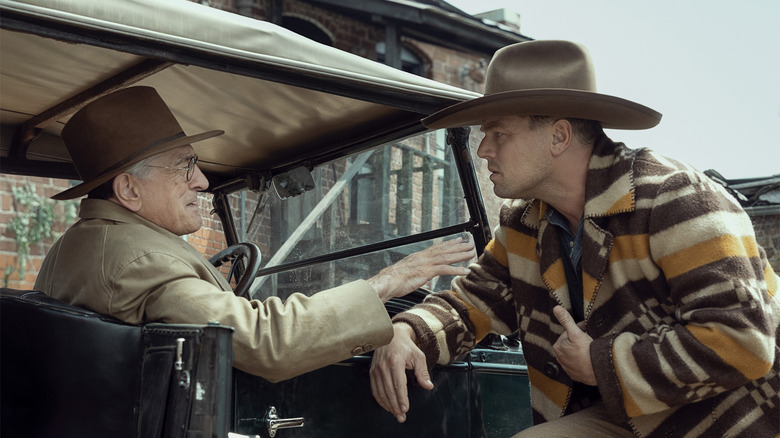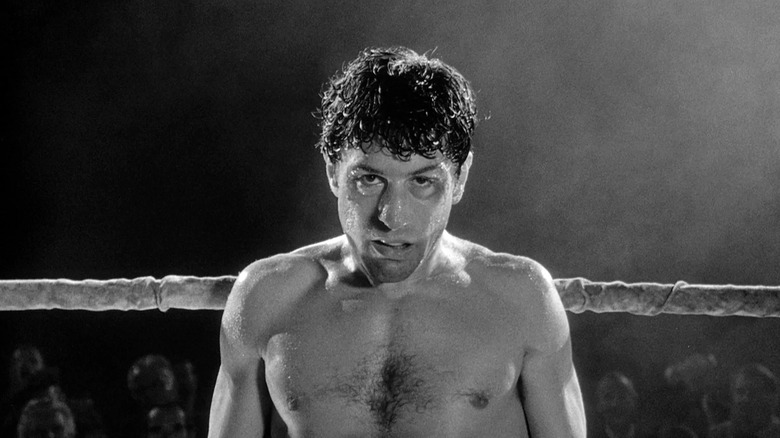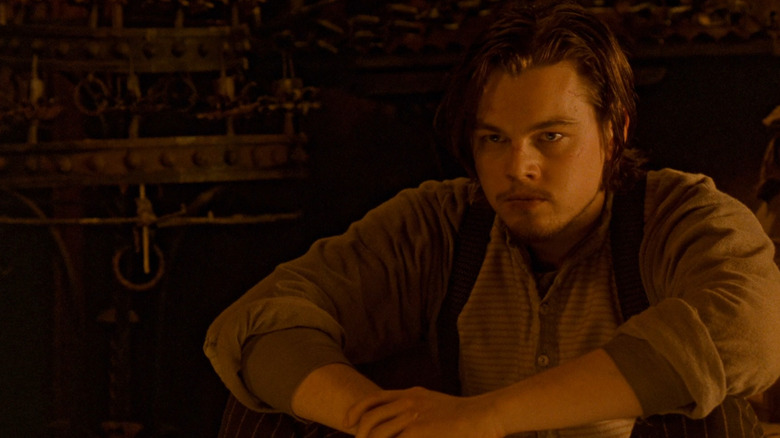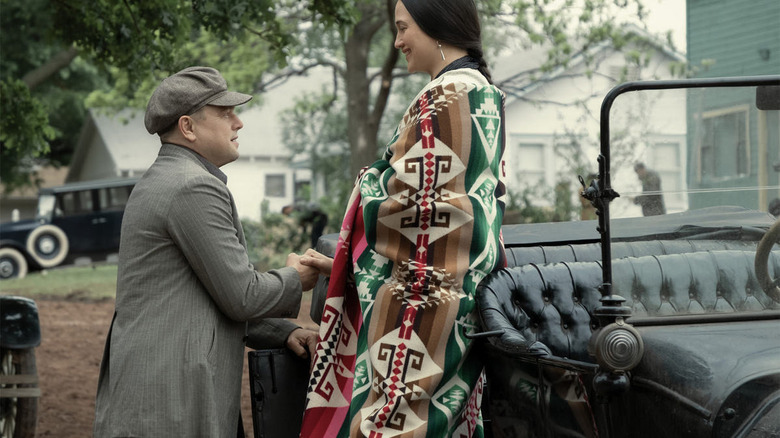Martin Scorsese Explains Why Robert De Niro And Leonardo DiCaprio Are His Most Trusted Collaborators
The idea of putting together a group that enjoys working as a team is a notion as old as time, yet there remains something special about the notion of an artistic repertory company. This is a group that exists not just to perform a task with a certain level of quality, but to explore each of their own personalities (as well as each other's) while plumbing the human condition for new corners of interest. In other words, it's about combining the familiarity and camaraderie of long-time friends and coworkers with the blank slate of artistic creation.
Of course, these explorations can't go as far or be as truthful without a remarkable amount of trust being involved, and that's precisely what director Martin Scorsese values in his own "repertory company" members. Some of Scorsese's detractors may think of his continued casting of Robert De Niro and Leonardo DiCaprio as a sort of laziness, but as he revealed in a recent press conference for his latest collaboration with both actors, "Killers of the Flower Moon," it's really all about the deep levels of trust he's formed with De Niro and DiCaprio. It's this trust that allows all three men to do work that, even separately, cannot reach such great levels of excellence as when they work together.
A lifelong bond
Of course, Scorsese's relationship with De Niro isn't the same kind of relationship as he has with DiCaprio. In the case of the former, the director described at a press conference attended by /Film's Ethan Anderton the way he and De Niro know each other so well thanks to growing up together:
"Well, in the case of Robert De Niro, we were teenagers together, and he's the only one who really knows where I come from. People I knew and that sort of thing. Some of them are still alive, he knows them. I know his friends, his old friends."
Using that rich personal history as a starting point, Scorsese and De Niro were able to create some indelible characters on screen, with both the director and the actor pushing their personal and artistic boundaries without interference from studios. The scrawny, nervy fear elicited by Travis Bickle in "Taxi Driver," the part ironic, part sincere tragedy of Jake La Motta in "Raging Bull," and the unnerving ambiguity of Rupert Pupkin in "The King of Comedy"; none of this could have happened without the bond between director and actor. Scorsese continued:
"And we had a real testing ground in the '70s where we tried everything and we found that we trusted each other. It's all about trust and love. It's what it is. And that's a big deal. Because very often if an actor has a lot of power, and he had a lot of power at that time, an actor could take over your picture. Studio gets angry with you, the actor comes in and takes it over. With him, I never felt that. I never felt that. There was a freedom. There was experimenting. And also, not afraid of anything. Wasn't afraid to do something, he just did it."
The kid gets in the picture
It only makes sense that De Niro and Scorsese would enjoy working together due to their common origins and like-mindedness. Thus, it's no surprise that Scorsese's other recurring on-screen alter ego didn't come out of nowhere; instead, Leonardo DiCaprio came personally recommended by De Niro himself. As Scorsese recalled:
"Years later [De Niro] told me he worked with this kid, Leo DiCaprio, a little boy in 'This Boy's Life.' And he said, 'You should work with this kid sometime.' But it was just casual. But with him, something like that, a recommendation at that time, I think in the early '90s, is not casual. He says it casually, but he rarely said that. He rarely gave recommendations. And so years go by and I'm presented with Leo, with 'Gangs of New York,' and we worked together in 'Gangs.' He made 'Gangs' possible, actually. He loved the pictures I made, and he wanted to explore the same territory."
Unlike the earlier, easier bond with De Niro formed by growing up together, Scorsese and DiCaprio had to build their own working relationship movie by movie. During this process, Scorsese was pleased to see the actor not only maturing as an artist but becoming more and more intrigued by the same art that changed the director's life years earlier:
"And so we developed more of a relationship when we did 'The Aviator.' And towards the end of it something happen[ed], a maturity with him. Not quite sure, but we really clicked in certain scenes. And that led to 'Departed,' and then that became much closer. [...] And so during that time, he really found out that even though it was 30 years difference, he has similar sensibilities. [...] He'll call me and say, 'I had a cold, and I was looking at Criterion films. And I wanted to catch up on some of these classics, and I saw this incredible movie. It's incredible. It's a Japanese picture, it's called 'Tokyo Story.' Did you ever see it?' This was last year. I said, 'Yeah.' [...] And that's very interesting to me to be open that way to older parts of our culture, newer parts of our culture. Of course, the curiosity that he has about other people and other cultures. And there's a trust. There's a trust. And even if we can't get it right away, we know we'll come up with something."
Using trust to find the answers and literally get going in the morning
In terms of how all this mutual trust, interest, and admiration translates into actually doing the work, Scorsese explained how it has to do with each artist pushing the other, encouraging explorations of the character and the scene. It also has to do with the person's energy, something which, in DiCaprio's case, inspires Scorsese during those rough mornings:
"Particularly doing 'Wolf of Wall Street,' by the way. [DiCaprio] came up with wonderful stuff that was outrageous. I pushed him, he pushed me. Then I pushed him more, then he pushed me, and suddenly everything was wild. It's really quite something. And he had a good energy too on the set, that was also important. Very important. Because in the mornings I'm not really good, and I get on set and then I'd see him or Jonah Hill, or him and Margot Robbie, or him and Lily [Gladstone], and suddenly they're all like, 'Hey.' I said, 'Okay, let's work.'"
Once the work begins, Scorsese and his collaborators take their time to find the truth of each moment and suss out what's best for the film as a whole. This process was particularly helpful for one of the climactic scenes in "Killers of the Flower Moon," as the director elaborated:
"Maybe other people have relationships where they come up with [things] faster. Well, we don't. We just work it through. For example, the scene between Leo and Bob in the jail at the end. That scene ultimately was finally written a few days before we shot it. Working with the two of them, and working with Marianne [Bower, producer] and everybody. Because we had said so much, and it could have gone so many different ways, but what does the picture really need? How much more is there for them to say to each other after all that's happened? And so we went that way. It's really, it's trust."
"Killers of the Flower Moon" is in theaters on Friday, October 20, 2023.



